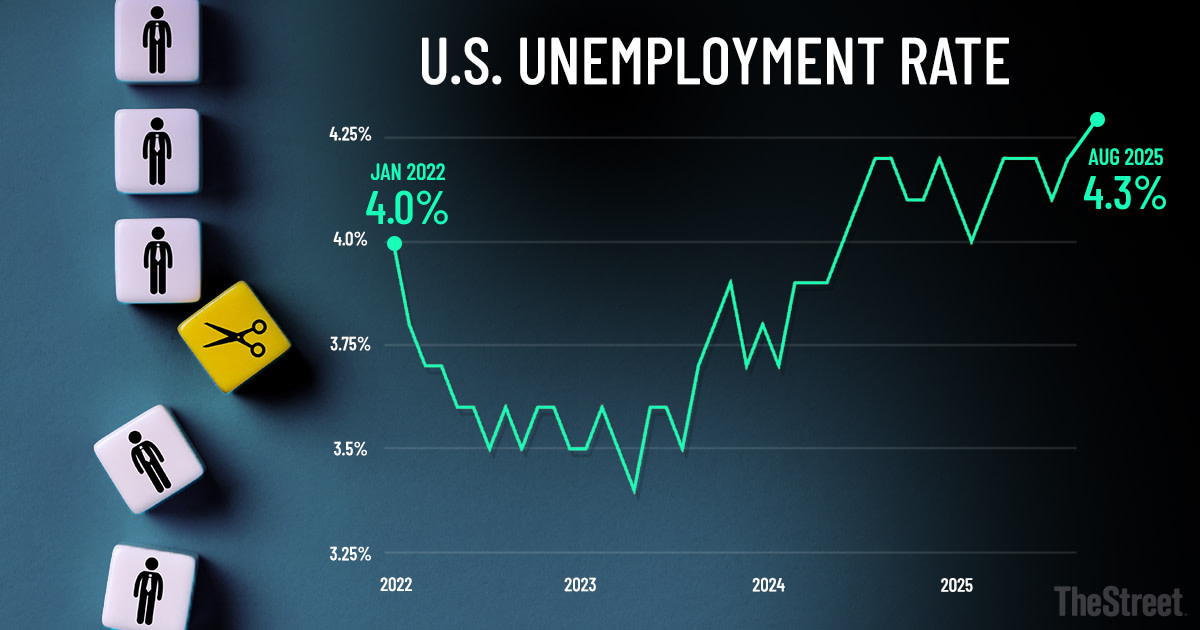The jobs market is struggling this year as companies cut costs to offset steep tariffs and government employment resets to reflect austerity stemming from DOGE-cuts earlier this year.
The weakness is evident across many measures, including layoffs and hiring.
- The unemployment rate has increased to 4.3% from its 3.4% low in 2023, according to the Bureau of Labor Statistics.
- Layoffs year-to-date through August total 892,362, up 66% year over year, according to Challenger, Gray, & Christmas.
- Only 7.2 milliion open, unfilled jobs were available nationwide in July, down from over 12 million in 2022.
The data suggests that the Federal Reserve will lower interest rates, given that low unemployment is one of its mandates, but not everyone believed cuts would happen this year — until now.
Bank of America has been steadfast in forecasting that the Federal Reserve will remain on the sidelines through 2025 because of inflation risks. However, following the BLS’s latest unemployment report for August, its analysts have changed their tune.
Bank of America predicts rate cut in September
Since summer 2024, the U.S. unemployment rate has been range-bound between 4% and 4.2%. However, that range was broken on September 5, when the August jobs data landed, showing unemployment rose to 4.3%.

TheStreet/Shutterstock
That’s the highest reading since October 2021, when it clocked in at 4.5%. The trend higher this year isn’t likely lost on the Federal Reserve.
The Fed is governed by a dual mandate:
- Low unemployment.
- Low inflation.
It’s not as simple as it sounds. The Fed indirectly controls the interest rates banks charge on loans by adjusting the Fed Funds Rate, the rate at which banks lend each other reserves overnight.
Related: Hiring data reveal disturbing job market trend
The problem, however, is that lower rates lower unemployment and increase inflation, and vice versa.
The mandate’s contradictory nature means that the Fed often finds itself behind the curve when setting its monetary policy, waiting to ensure that it doesn’t cause one problem while trying to fix another.
For this reason, Fed Chairman Jerome Powell has kept rates unchanged this year, worried that reducing them could fan inflationary flames even as the full impact of tariffs lands.
There’s certainly evidence that he’s not wrong about inflation, given the Consumer Price Index has risen to 2.7% from 2.3% since April, when most tariffs were announced.
CPI inflation since April:
- July: 2.7%
- June: 2.7%
- May: 2.4%
- April: 2.3%
Source: Bureau of Labor Statistics
That argument has been a big reason Bank of America has maintained its outlook for no rate cuts in 2025 until now.
Related: Fresh labor market data fuel Fed interest rate cut chatter
After the unemployment rate reached a new cycle high in August, BofA’s analysts now believe that the Fed’s hands will be forced, resulting in a 0.25% cut to the Fed Funds Rate on September 17 when the FOMC next meets to decide policy:
“The Aug jobs report should cement a shift in the Fed’s thinking from worrying about inflation to focusing on labor weakness… We now expect the Fed to cut by 25bp each in Sep & Dec,” wrote the analysts in a research note shared with TheStreet.
“It’s not surprising that BofA is evolving its thinking on rate cuts following the softening in August job creation noted from multiple sources, not just the August Employment Report,” said TheStreet Pro’s veteran fund manager Chris Versace. “The question now, in the face of elevated inflation data, how many rate cuts might the Fed deliver this year? Next week’s August CPI and PPI may help us sort that out.”
According to the CME’s popular FedWatch tool, the probability of a quarter-percentage-point rate cut in September is 88%, and chances for a half-point cut have climbed to 12% from 0% on September 4, before the unemployment report release.
More rate cuts could be coming through 2026
Bank of America doesn’t think the Fed will take a ‘one and done’ style approach to lowering interest rates.
More Economic Analysis:
- Fed official sends bold 5-word message on September rate cuts
- New inflation report may have major impact on your wallet
- Surprising GDP report resets backdrop for stocks
They say a rate cut is “on the table” for October, but that’s not the base case. Instead, it models two cuts in 2025, followed by even lower interest rates in 2026.
The analysts expect Fed Chair Powell and company to lower interest rates by one-half of a percentage point in 2025, followed by “another 75bp next year, for a terminal rate of 3.00-3.25%.”
If so, that would represent a total of 2.25% worth of rate cuts from the peak Fed Funds Rate last year, including the 1% worth of cuts at the end of 2024.
Related: Here’s how stocks react to Fed interest rate cuts
#Bank #America #announces #huge #shift #Fed #rate #cut #forecast